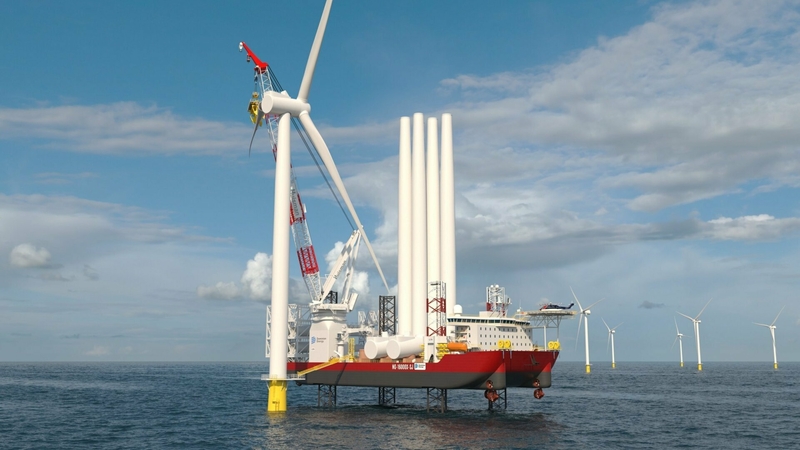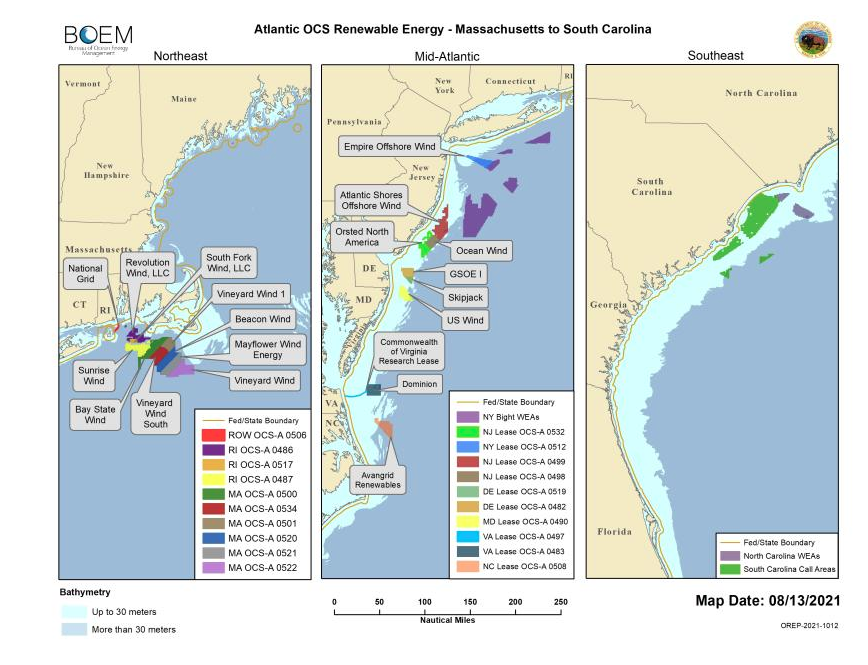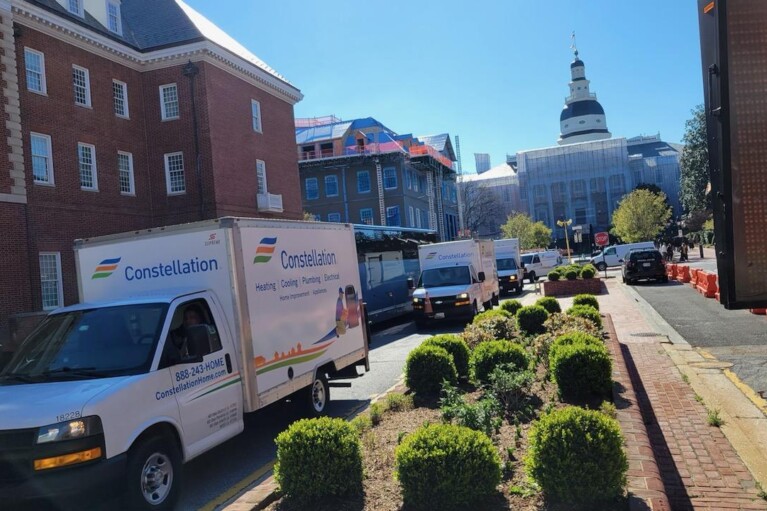Offshore wind will need major investments in transmission, supply chain, reports say

Achieving the aggressive offshore wind power goals of the federal government and individual states will require billions of dollars in spending on transmission infrastructure, “unprecedented” cooperation between grid operators and federal and state agencies, and would be aided by major buildout of a domestic supply chain, per a pair of recent reports.
Coastal states across the country, from California to Louisiana to Maine, are pushing for offshore wind projects, but the reports see potential bottlenecks looming, both in the supply chain to build and install turbines as well as in the ability to bring the electricity ashore.
The National Renewable Energy Laboratory, along with the Business Network for Offshore Wind and Tufts University, among other partners, released a report last week that found that creating an American supply chain for the offshore wind industry, including manufacturing facilities, ports and vessels, would make hitting the Biden administration’s 30-gigawatts-by-2030 target, roughly the equivalent of 30 nuclear reactors, more likely.
“Ambitious global offshore wind energy deployment targets will create substantial demand for the components needed to build these wind turbines and balance-of-system components such as foundations and cables,” says the report.
“The limited global manufacturing capacity for these components creates a risk for U.S. projects that choose to import their components from Europe. Therefore, developing a domestic supply chain would reduce reliance on global manufacturers and create jobs and economic benefits in the United States.”
The report’s authors envision a supply chain buildout scenario that includes 34 new major U.S. wind turbine component manufacturing facilities, eight East Coast “marshaling ports,” four to six dedicated turbine installation vessels (there is currently just one being built now for Virginia’s Dominion Energy) another four to six dedicated heavy lift vessels and four to six feeder barges and a workforce about 45,000 strong. The price tag? About $22.4 billion. And it would take between six and nine years to develop, the report says, but would be worth the investment.

Offshore wind lease areas along the East Coast. Image from the U.S. Bureau of Ocean Energy Management.
“If individual states leverage their existing manufacturing capabilities to contribute to the offshore wind energy sector, this conceptual supply chain would generate significant workforce and economic benefits throughout the United States, not just in coastal locations with active offshore wind energy programs,” the authors wrote.
With two companies, Ørsted and US Wind, holding leases to erect install offshore wind energy developments off the coast of Ocean City, company executives and state and local government officials anticipate Maryland becoming a regional hub for turbine construction and services.
At the massive Tradepoint Atlantic industrial complex in Baltimore County, US Wind has a $77 million agreement to open a port facility to service the wind developments, and envisions building a steel fabrication facility there for turbine construction.
Ørsted also plans to build a facility at Tradepoint Atlantic to build and assemble turbines, and has signed a $70 million contract with Crystal Steel Fabricators Inc. in Federalsburg to fabricate steel for turbine components.
Several other facilities are under construction on the Eastern Shore to help build and service the wind projects, deliver emergency services, and provide transportation to and from the turbines.
Uncertainty around potential construction delays, cost overruns, legal complications, or possible changes in government support for offshore wind make it hard to get financing for factories, vessels and port investments that would build the supply chain, the report says.
While the 2022 U.S. Inflation Reduction Act, which extended existing tax credits for clean energy projects and created new advanced manufacturing credits applicable to offshore wind turbine components, among other incentives, will help American-made offshore wind components compete with imports, “additional incentives may be required to encourage domestic manufacturing of components or supply chain assets that are either not considered in the IRA or receive credits that are smaller than the cost premium for domestic manufacturing,” the report says.
The authors encourage the U.S. Bureau of Ocean Energy Management, which leases federal waters for offshore wind, to consistently open new lease areas to encourage a steady stream of development and they note that states and utilities setting new offshore wind procurement targets will help provide “predictability and stability” for the fledgling industry.
The report also makes a range of recommendations on turning high-level cooperative frameworks — like Virginia, Maryland and North Carolina’s memorandum of understanding to make the Southeast and mid-Atlantic an offshore wind hub and the Federal-State Offshore Wind Implementation Partnership — into more concrete supply chain moves. Those include standardizing regulations and permitting, identifying prime locations for supply chain facilities and establishing long-term plans for supply chain investment to “provide a strong and clear demand for the industry” in the event of shifting national policy, among other recommendations.
Transmission planning
And then there’s the matter of connecting all that new offshore electric generation to the grid.
The second report, prepared by the Brattle Group, a consulting firm specializing in economics, finance and regulation, on behalf of a group of clean energy and climate-focused organizations, urges state and federal policymakers, electric industry regulators and grid managers to begin planning offshore wind transmission now to identify the most cost-effective solutions. The report notes that while the federal government has a goal of 30 gigawatts by 2030, the wind procurements and goals of 11 coastal states will surpass 50 gigawatts by 2035 and will hit 77 gigawatts by 2045. (For comparison, natural gas power plant capacity, the largest single U.S. generation source, was 278 gigawatts in 2021.)
“While the most ambitious state and federal clean energy goals will not have to be attained until 2040 or 2050, we project that starting proactive planning for these long-term offshore wind generation needs now likely will save U.S. consumers at least $20 billion and reduce environmental and community impacts by 50%,” the report says.
The U.S. electric grid was designed to bring electricity to the coast, not the other way around. That means connecting the large amount of power planned to be produced by offshore wind farms to the homes, businesses and industries that will use it will require big upgrades to the transmission system.
However, the flow of electricity in much of the country is under the jurisdiction of regional transmission operators, which, in addition to matching electric supply and demand, also generally oversee interconnection requests for new generators and plan for necessary transmission upgrades. To accommodate offshore wind cost effectively, the report says, “requires improved and well-coordinated generation interconnection and transmission planning processes by the regional independent transmission system operators,” which have been plagued by long interconnection queues and caught up in debates over planning and how the costs of interconnection should be allocated.
Critics have complained that the grid operators have been slow to come to grips with the surge in renewable projects entering their interconnection queues and are stuck in blinkered planning regimes.
Better planning, though, would mean less ocean cable, fewer onshore interconnection points and environmental effects and lower costs for customers. And it needs to start now because of the long timeline (at least a decade) offshore wind transmission projects require, the report says.
“Any planning steps taken today are unlikely to yield significant new transmission infrastructure until the early 2030s,” the authors wrote.
The report noted that the largest U.S. grid operator, PJM, struck an agreement with New Jersey to conduct a planning and solicitation process for transmission upgrades necessary to accommodate its offshore wind goals (one of the nation’s most ambitious) that will save customers about $900 million and reduce interconnection risks for developers, making future offshore wind procurements more competitive, among other benefits.
“If the scope of the planning effort had been broader than just for offshore wind and only for New Jersey, the benefits would have been even larger,” the report says.
The study calls for beefing up staffing and budgets at state regulatory agencies, empowering new or existing “regional, multi-state decision-making bodies,” such as new multistate transmission authorities possibly modeled on the Regional Greenhouse Gas Initiative, proactive identification of feasible interconnection points, streamlined federal permitting for third-party transmission developers, new cost-allocation frameworks and better regional and interregional planning processes, among others.
In Maryland, Sen. Brian Feldman (D-Montgomery), chair of the Committee on Education, Energy and the Environment, said Friday that he expects legislation to be introduced in the current legislative session to help bolster electricity transmission and modernize the grid. He also said an anticipated windfall in federal funding should help the state accomplish those goals.
“It’s a national issue,” Feldman said. “We’ve got a lot of energy generation in the Midwest that currently, in the United States, can’t get to the East Coast. Offshore wind – how do you get the energy from offshore? These are important issues that are necessary for us to address in a really smart way.”
Asked whether any states are serving as models in the effort to modernize the grid and boost transmission services, Feldman replied, “I’d like us to be the leader in the country and candidly I think we have a great shot, for political reasons, where we’re located. Talk about offshore wind, not everyplace in the United States has the ability to do that. And I think politically, we’ve got everything in place, a governor who is talking about this issue. We’ve got new cabinet secretaries who are very supportive of the things we’re talking about. So I think we’re aligned finally.
“The last eight years have been a bit of a challenge. You talk about the Maryland Energy Administration, during the Hogan years, MEA was essentially gutted, and now I think it’s part of our job as legislators to build up some of these executive branch agencies. Former Sen. [Paul] Pinsky is going to be heading that, so this is an all-hands-on-deck operation. I don’t think any state has nailed this yet but I hope for us to be at the top of the food chain.”
A proposed rule by the Federal Energy Regulatory Commission, aimed at improving regional transmission planning by better quantifying the benefits of upgrades, could help offshore wind development down the road, said Johannes Pfeifenberger, a principal at the Brattle Group and a co-author of the report, in an interview.
But in the short term, he says, it’s important for states with offshore wind goals to follow New Jersey’s lead and team up with each other and grid operators to identify the optimal interconnection locations and transmission corridors, among other planning steps.
“This is a complex dance that requires multiple steps,” he said. “The urgency is certainly important. Unless we do many of these things right now we will have lost opportunities to achieve better outcomes. … The other takeaway at least in my mind is the governors really have the opportunity to make this work on a multi-state level. But unless the governors get involved or state legislators get involved we don’t have any entities that have decision-making powers.”





 Creative Commons Attribution
Creative Commons Attribution